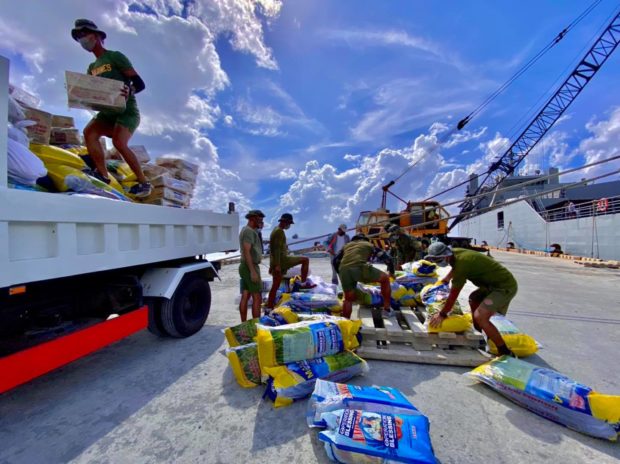
AID FOR IVATANS Medical and food supplies from various donors are unloaded at the port in Basco, Batanes, on Sept. 25 intended for residents affected by Typhoon “Kiko” (international name: Chanthu) that hit the province on Sept. 11. The province is facing a surge in coronavirus cases even as it still has to recover from the impact of the typhoon. —PHOTO COURTESY OF THE PHILIPPINE NAVY
ITBAYAT, Batanes, Philippines — A year and a half since the coronavirus pandemic struck, the island province of Batanes recorded its first fatality to the dreaded disease.
The 70-year-old man from the capital town of Basco died on Saturday after suffering from acute respiratory failure secondary to pneumonia and high-risk COVID-19, Batanes provincial information officer Justinne Socito told the Inquirer on Monday.
His death came as the province, where the pandemic was largely not felt by its 18,831 population (2020 census), suddenly found itself in the middle of a COVID-19 surge, with 349 active cases, including 67 new infections logged over the weekend.
Most of these active cases involved residents of Basco (254) while the others were from the towns of Uyugan (25), Mahatao (24), Ivana (19), Itbayat (14) and Sabtang (13).
One of the patients remained in critical condition and is now confined at Batanes General Hospital (BGH) in Basco, the only COVID-19 hospital in the province, according to the local interagency task force. Seven other cases were categorized as severe infections while 341 were mild.
Until the sudden surge in cases since the third week of this month, Batanes only had a handful of infections toward the last quarter of 2020, all of whom were returning residents who had since recovered. This time, the infections involved residents who had no known travel outside of the island province.
Hospital capacity
Since last year, the province has recorded 366 COVID-19 cases, with 17 recoveries, local health records showed.
The entry of COVID-19 in the province happened at a time when Batanes was still recovering from the widespread destruction wrought by Typhoon “Kiko” (international name: Chanthu), which ravaged the island on Sept. 11.As of Monday, BGH’s bed occupancy rate was at 79.2 percent, with only five of its 24 COVID-19 beds still vacant. All of its six intensive care unit beds were occupied while 13 of its 18 isolation beds were in use, data from the Department of Health showed. According to local health officials, the province recorded its first community transmission in Basco on Sept. 18 after four residents tested positive for COVID-19 without a known source.
Surge in Aurora, La Union
As Batanes hunkered down and stopped travel in and out of the island, it allowed the Philippine Navy’s BRP Dagupan City LC551 to dock at the port of Basco on Sept. 25, to unload food and medical supplies from various donors that were intended for the typhoon-hit residents.
MAKESHIFT SHELTERS Large isolation tents are put up at a covered court in Itbayat town, Batanes, last week, as the remote island province continues to experience a surge in COVID-19 cases. —NATHAN ALCANTARA
At least 500 shelter-grade tarpaulins were also donated by the Bureau for Humanitarian Assistance of the US Agency for International Development to the Ivatan families whose houses were damaged by the typhoon.
In Aurora province, all hospitals and quarantine facilities for COVID-19 patients had stopped accepting COVID-19 patients as they reached their full capacity as of Sunday, according to Gov. Gerardo Noveras.
In a statement, Noveras said even the dome tents within the provincial hospital’s compound were filled with patients.
“There have been so many depressing stories of deaths in our province due to COVID-19. Most of them were about ignoring the symptoms they were feeling until it was already too late for them to receive medical attention and treatment,” he said.
Aurora’s active COVID-19 cases rose to 311 after recording 23 new cases on Sunday.
In La Union province, health authorities said the capital city of San Fernando might revert to enhanced community quarantine (ECQ) for two weeks beginning Oct. 1 after it detected its first Delta variant case on Sept. 25.
The imposition of ECQ, the most restrictive containment classification in the country, would allow the city to contain the spread of the virus, said San Fernando Mayor Hermenegildo Gualberto.
As of Sept. 25, the city’s active COVID-19 cases rose to 1,063, according to the data from the city government.